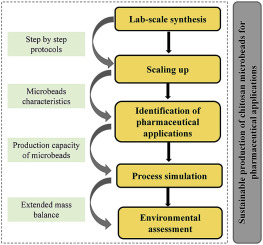Sustainable Chemistry and Pharmacy ( IF 6 ) Pub Date : 2020-01-09 , DOI: 10.1016/j.scp.2020.100212 K. Moreno-Sader , S.I. Meramo-Hurtado , A.D. González-Delgado

|
In recent decades, pharmaceutical uses of chitosan microbeads have been identified owing to their low toxicity, biocompatibility and biodegradability. However, many contributions have limited such microbeads preparation to lab-scale and there are no works reported in the literature about the scaling-up of chitosan microbeads production. To fill the knowledge gap, this research attempts to simulate and evaluate the environmental performance of large-scale production of chitosan microbeads under sustainability concept using computer-aided process engineering (CAPE). The extended energy and mass balances were provided by process simulation using the commercial software Aspen Plus ®. The environmental assessment was performed through two computer-aided tools: waste reduction (WAR) algorithm and Tool for the Reduction and Assessment of Chemical and other Environmental Impacts (TRACI). Results reported negatives values for total generation rate of Potential Environmental Impacts (PEI) (−1.16 × 10+2, −9.25 × 10+1, −1.00 × 10+2 and −7.66 × 10+1 PEI/hr) and highest total output rate of PEI for cases 4 and 3 (considering energy flows contributions). For TRACI tool, potential environmental impacts were low, however, the freshwater ecotoxicity potential for freshwater emissions was higher (6.03E+02 CTUeco/hr) than for natural soil emissions (1.55E+02 CTUeco/hr). These results showed good environmental performance of the process and can be used as a benchmark in the production of more environmental-friendly chitosan microbeads at large-scale.
中文翻译:

通过计算机辅助模拟,WAR和TRACI评估,对药用壳聚糖微珠生产进行环境可持续性分析
近几十年来,由于壳聚糖微珠的低毒性,生物相容性和可生物降解性,已经确定了其药物用途。然而,许多贡献将这种微珠的制备限于实验室规模,并且在文献中没有关于放大壳聚糖微珠产量的文献报道。为了填补知识空白,本研究尝试使用计算机辅助过程工程(CAPE)在可持续性概念下模拟和评估大规模生产壳聚糖微珠的环境绩效。扩展的能量和质量平衡是使用商业软件Aspen Plus®通过过程模拟提供的。通过两种计算机辅助工具进行了环境评估:废物减少(WAR)算法和减少和评估化学及其他环境影响(TRACI)的工具。结果报告了潜在环境影响(PEI)的总产生率的负值(-1.16×10+2,-9.25×10 +1,-1.00×10 +2和-7.66×10 +1 PEI / hr)和情况4和3的PEI最高总输出速率(考虑能量流贡献)。对于TRACI工具而言,潜在的环境影响很小,但是,淡水排放的淡水生态毒性潜力(6.03E + 02 CTUeco / hr)要比天然土壤排放的高(1.55E + 02 CTUeco / hr)高。这些结果表明该方法具有良好的环境性能,可作为大规模生产更环保的壳聚糖微珠的基准。


























 京公网安备 11010802027423号
京公网安备 11010802027423号